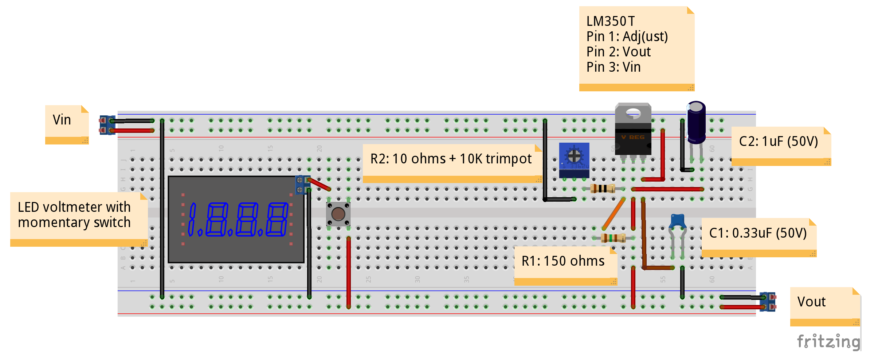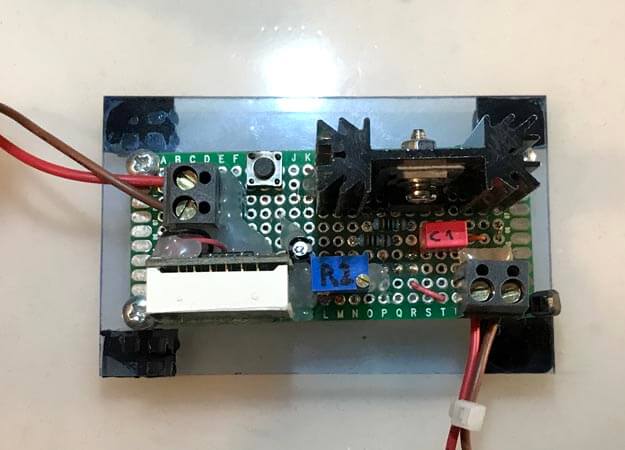| |
LM350 3A Adjustable Voltage Regulator |
|
The LM350 is a tried and true 3A adjustable voltage regulator. It accepts an input voltage up to 35V and can deliver an output voltage between 1.25 and 33V. It is rugged beyond belief. Where fairly beefy step-down converters go up in smoke, the LM350 just takes a nap. And a nap is infinitely better than a plume of smoke. LM350 can also be used to limit current though that requires a separate LM350/LM317 in series with our voltage regulator.

I needed a very low-noise variable power supply for some irrelevant project, and having tested a handful of step-down converters on an oscilloscope, I really was annoyed. They are nice, but they are noisy. This circuit required as little noise as possible, and to compound my irritation, my modified desk PSU was doubly noisy. The M317 has an absolute maximum current limit of 1.5A, which was too little for my project, so I got a LM350, and was instantly satisfied.
The LM350 accepts an input voltage up to 35V, can output 3A, and can deliver an output voltage of between 1.25 and 33V. It will enter a temporary coma if overheated, and really requires serious abuse before it dies. As a voltage regulator of the old school, it does require some heatsinking, but heatsinks are cheap. For this variable voltage regulator, a heatsink that can dissipate 5 watts is used. It is best to keep the input voltage as close to the output voltage as possible, since the formula: ‘P_dissipate = ( Vin – Vout ) * Iload’ tells us that for e.g. (12V – 5V) * 0.5A = 3.5 watts must be dissipated. And that’s for the standard effect of a USB2.0 port, regulated down from 12V. For P_dissipate = ( 6.5V – 5V ) * 0.5 we get 0.75 watts, a more reasonable amount of wasted energy turned into heat, and that will easily be dissipated. The formula for calculating voltage output is:
Vout = 1.25 * ( 1 + ( 150 / ( R1+10 ) ) = ?V
Notice that there is a 10 ohm resistor in series with the trimpot, yielding a minimum output voltage of 1.33V.
The pinout of the LM350T is pin 1: Adj(ust), pin 2: Vout, pin 3: Vin. While I have seen perfectly clean power output on a LM350 under load, we will add some capacitors to trim the input and output. These soak up noise, and though not strictly necessary, every little bit helps. We use a 0.33uF capacitor on Vin (C1), and an electrolytic (polarized) capacitor with a value of 1uF on Vout (C2) to improve transient response. The LM350 much enjoys a 150 ohm resistor (R1) between Adj and Vout. For R2 we use a 10 ohm resistor in series with a 10K ohm trimpot to gain variable output voltage. You can use the lm317_calc.py script from our 12V battery charge controller article. Here we do NOT use any protection diodes, but if you plan on using an output voltage greater than or equal to 25V, you should definitely include them.
For added convenience, a digital voltmeter is added, but since it does cause spikes in the output current (a few millivolts), it is OFF until you press the little button by the input terminals. It is easy enough to adjust the little trimpot whilst holding down that button. If at any time you need to know the output voltage, just press it again. The one used here was a bit off, by plus 0.12V. Unless it’s an expensive LED voltmeter, it seems this is very common. You may want to consider an analogue voltmeter if you want to avoid noise and have a permanent display of output voltage.
Components Required
1 x LM350T variable voltage regulator (TO-220 package)
1 x heatsink of arbitrary size (38x34x12.8mm TO-220 finned heatsink)
1 x TO-220 insulating thermal pad + plastic sheath
1 x 3mm nut + bolt
A drop of thermal paste
1 x LED voltmeter (optional)
1 x momentary pushbutton (optional)
2 x 2 port screw terminal
1 x 50x70mm perfboard
1 x 150 ohm resistor for R1
1 x 10 ohm resistor for R2.1 (in series with R2.2, min. output => 1.33V)
1 x 5-10 kilo-ohm trimpot for R2.2
1 x 0.33uF capacitor (50V) for C1
1 x 1uF electrolytic capacitor (50V) for C2
Follow the schematic, and don’t be shy. The LM350T can endure 300 degrees celsius for up to 10 seconds, and that tastes like freedom. Pay attention to a proper electric insulation between the heatsink and the LM350T. Test continuity from the tab to the heatsink after you’ve mounted it. If you have no continuity test on your multimeter, use the 200 ohms setting. Of course, if you don’t mind having Vout on the tab as well as pin 2, you can skip this step.
You may have noticed the splodges of silicone glue on the example board. There is a reason for that – particularly trimpots and capacitors don’t handle being moved ever so slightly over longer periods of time. Your solder joints may be solid, but even this malleable metal from which the pins are made will eventually succumb to metal fatigue. When they break, you’ll have to fix it. This board lives in my special Box of Many Things, and I will regularly jostle that box around, rummage through it, and so forth. By applying a few unsightly blobs of glue you can be certain that nothing falls apart. The higher the temperature, the better the bonding!
If you’ve followed the schematic, you now have a very nice little power supply. I retired my puny buck-boost supply after I started using this one. The device would benefit from a larger heatsink, but this is not something intended for permanent installation somewhere – at most, I’ll pull 500-750mA of continuous current. And remember: the output current is so squeaky clean it can even be used for RF applications. If you’ve got a circuit that’s misbehaving, and you suspect the culprit is noise, try using this to supply power – particularly the HopeRF 433/868MHz and longer range LoRa SX1278 radio modules will benefit greatly.

Related Links
Downloads
LM350 3A Adjustable Voltage Regulator - Link
|
|
|
| |
Accurate LC Meter
Build your own Accurate LC Meter (Capacitance Inductance Meter) and start making your own coils and inductors. This LC Meter allows to measure incredibly small inductances making it perfect tool for making all types of RF coils and inductors. LC Meter can measure inductances starting from 10nH - 1000nH, 1uH - 1000uH, 1mH - 100mH and capacitances from 0.1pF up to 900nF. The circuit includes an auto ranging as well as reset switch and produces very accurate and stable readings. |
|
PIC Volt Ampere Meter
Volt Ampere Meter measures voltage of 0-70V or 0-500V with 100mV resolution and current consumption 0-10A or more with 10mA resolution. The meter is a perfect addition to any power supply, battery chargers and other electronic projects where voltage and current must be monitored. The meter uses PIC16F876A microcontroller with 16x2 backlighted LCD. |
|
|
|
60MHz Frequency Meter / Counter
Frequency Meter / Counter measures frequency from 10Hz to 60MHz with 10Hz resolution. It is a very useful bench test equipment for testing and finding out the frequency of various devices with unknown frequency such as oscillators, radio receivers, transmitters, function generators, crystals, etc. |
|
1Hz - 2MHz XR2206 Function Generator
1Hz - 2MHz XR2206 Function Generator produces high quality sine, square and triangle waveforms of high-stability and accuracy. The output waveforms can be both amplitude and frequency modulated. Output of 1Hz - 2MHz XR2206 Function Generator can be connected directly to 60MHz Counter for setting precise frequency output. |
|
|
|
BA1404 HI-FI Stereo FM Transmitter
Be "On Air" with your own radio station! BA1404 HI-FI Stereo FM Transmitter broadcasts high quality stereo signal in 88MHz - 108MHz FM band. It can be connected to any type of stereo audio source such as iPod, Computer, Laptop, CD Player, Walkman, Television, Satellite Receiver, Tape Deck or other stereo system to transmit stereo sound with excellent clarity throughout your home, office, yard or camp ground. |
|
USB IO Board
USB IO Board is a tiny spectacular little development board / parallel port replacement featuring PIC18F2455/PIC18F2550 microcontroller. USB IO Board is compatible with Windows / Mac OSX / Linux computers. When attached to Windows IO board will show up as RS232 COM port. You can control 16 individual microcontroller I/O pins by sending simple serial commands. USB IO Board is self-powered by USB port and can provide up to 500mA for electronic projects. USB IO Board is breadboard compatible. |
|
|
|
|
ESR Meter / Capacitance / Inductance / Transistor Tester Kit
ESR Meter kit is an amazing multimeter that measures ESR values, capacitance (100pF - 20,000uF), inductance, resistance (0.1 Ohm - 20 MOhm), tests many different types of transistors such as NPN, PNP, FETs, MOSFETs, Thyristors, SCRs, Triacs and many types of diodes. It also analyzes transistor's characteristics such as voltage and gain. It is an irreplaceable tool for troubleshooting and repairing electronic equipment by determining performance and health of electrolytic capacitors. Unlike other ESR Meters that only measure ESR value this one measures capacitor's ESR value as well as its capacitance all at the same time. |
|
Audiophile Headphone Amplifier Kit
Audiophile headphone amplifier kit includes high quality audio grade components such as Burr Brown OPA2134 opamp, ALPS volume control potentiometer, Ti TLE2426 rail splitter, Ultra-Low ESR 220uF/25V Panasonic FM filtering capacitors, High quality WIMA input and decoupling capacitors and Vishay Dale resistors. 8-DIP machined IC socket allows to swap OPA2134 with many other dual opamp chips such as OPA2132, OPA2227, OPA2228, dual OPA132, OPA627, etc. Headphone amplifier is small enough to fit in Altoids tin box, and thanks to low power consumption may be supplied from a single 9V battery. |
|
|
|
|
|
Arduino Prototype Kit
Arduino Prototype is a spectacular development board fully compatible with Arduino Pro. It's breadboard compatible so it can be plugged into a breadboard for quick prototyping, and it has VCC & GND power pins available on both sides of PCB. It's small, power efficient, yet customizable through onboard 2 x 7 perfboard that can be used for connecting various sensors and connectors. Arduino Prototype uses all standard through-hole components for easy construction, two of which are hidden underneath IC socket. Board features 28-PIN DIP IC socket, user replaceable ATmega328 microcontroller flashed with Arduino bootloader, 16MHz crystal resonator and a reset switch. It has 14 digital input/output pins (0-13) of which 6 can be used as PWM outputs and 6 analog inputs (A0-A5). Arduino sketches are uploaded through any USB-Serial adapter connected to 6-PIN ICSP female header. Board is supplied by 2-5V voltage and may be powered by a battery such as Lithium Ion cell, two AA cells, external power supply or USB power adapter. |
|
200m 4-Channel 433MHz Wireless RF Remote Control
Having the ability to control various appliances inside or outside of your house wirelessly is a huge convenience, and can make your life much easier and fun. RF remote control provides long range of up to 200m / 650ft and can find many uses for controlling different devices, and it works even through the walls. You can control lights, fans, AC system, computer, printer, amplifier, robots, garage door, security systems, motor-driven curtains, motorized window blinds, door locks, sprinklers, motorized projection screens and anything else you can think of. |
|
|
|